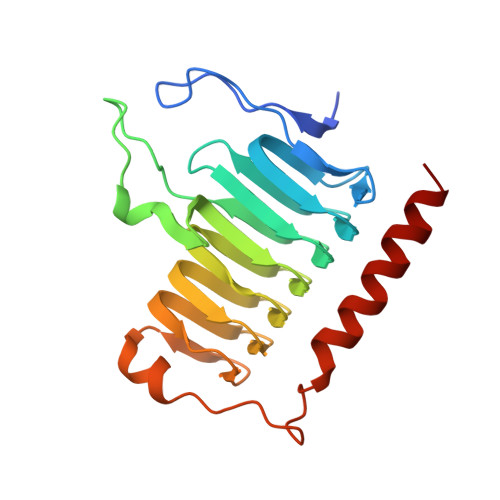A closer look at the active site of gamma-class carbonic anhydrases: high-resolution crystallographic studies of the carbonic anhydrase from Methanosarcina thermophila.
Iverson, T.M., Alber, B.E., Kisker, C., Ferry, J.G., Rees, D.C.(2000) Biochemistry 39: 9222-9231
- PubMed: 10924115
- DOI: https://doi.org/10.1021/bi000204s
- Primary Citation of Related Structures:
1QQ0, 1QRE, 1QRF, 1QRG, 1QRL, 1QRM - PubMed Abstract:
The prototype of the gamma-class of carbonic anhydrase has been characterized from the methanogenic archaeon Methanosarcina thermophila. Previously reported kinetic studies of the gamma-class carbonic anhydrase are consistent with this enzyme having a reaction mechanism similar to that of the mammalian alpha-class carbonic anhydrase. However, the overall folds of these two enzymes are dissimilar, and apart from the zinc-coordinating histidines, the active site residues bear little resemblance to one another. The crystal structures of zinc-containing and cobalt-substituted gamma-class carbonic anhydrases from M. thermophila are reported here between 1.46 and 1.95 A resolution in the unbound form and cocrystallized with either SO(4)(2)(-) or HCO(3)(-). Relative to the tetrahedral coordination geometry seen at the active site in the alpha-class of carbonic anhydrases, the active site of the gamma-class enzyme contains additional metal-bound water ligands, so the overall coordination geometry is trigonal bipyramidal for the zinc-containing enzyme and octahedral for the cobalt-substituted enzyme. Ligands bound to the active site all make contacts with the side chain of Glu 62 in manners that suggest the side chain is likely protonated. In the uncomplexed zinc-containing enzyme, the side chains of Glu 62 and Glu 84 appear to share a proton; additionally, Glu 84 exhibits multiple conformations. This suggests that Glu 84 may act as a proton shuttle, which is an important aspect of the reaction mechanism of alpha-class carbonic anhydrases. A hydrophobic pocket on the surface of the enzyme may participate in the trapping of CO(2) at the active site. On the basis of the coordination geometry at the active site, ligand binding modes, the behavior of the side chains of Glu 62 and Glu 84, and analogies to the well-characterized alpha-class of carbonic anhydrases, a more-defined reaction mechanism is proposed for the gamma-class of carbonic anhydrases.
- Graduate Option in Biochemistry, California Institute of Technology, Pasadena 91125, USA.
Organizational Affiliation:

















